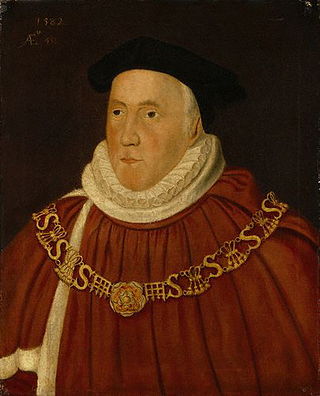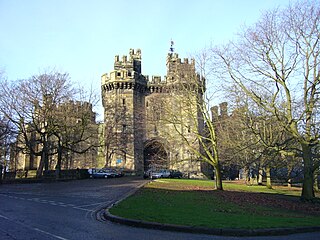Related Research Articles

Matthew Hopkins was an English witch-hunter whose career flourished during the English Civil War. He claimed to hold the office of Witchfinder General, although that title was never bestowed by Parliament, and was mainly active in East Anglia.

Samuel Sewall was a judge, businessman, and printer in the Province of Massachusetts Bay, best known for his involvement in the Salem witch trials, for which he later apologized, and his essay The Selling of Joseph (1700), which criticized slavery. He served for many years as the chief justice of the Massachusetts Superior Court of Judicature, the province's high court.

The North Berwick witch trials were the trials in 1590 of a number of people from East Lothian, Scotland, accused of witchcraft in the St Andrew's Auld Kirk in North Berwick on Halloween night. They ran for two years, and implicated over seventy people. These included Francis Stewart, 5th Earl of Bothwell, on charges of high treason.
Sir William Oliphant, Lord Newton (1551–1628) was a Scottish judge.

Edward LeSaint was an American stage and film actor and director whose career began in the silent era. He acted in over 300 films and directed more than 90. He was sometimes credited as Edward J. Le Saint.

Jonathan Corwin was a New England merchant, politician, and magistrate. He is best known as one of the judges involved in the Salem witch trials of 1692, although his later work also included service as an associate justice of the Massachusetts Superior Court of Judicature, the highest court of the Province of Massachusetts Bay.

Sir Christopher Wray was an English judge and Chief Justice of the King's Bench.

The Northamptonshire witch trials mainly refer to five executions carried out on 22 July 1612 at Abington Gallows, Northampton. In 1612 at the Lent Assizes held in Northampton Castle a number of women and a man were tried for witchcraft of various kinds, from murder to bewitching of pigs. There are two main accounts of these witches being tried. However they differ on how many witches were tried, who they were and exactly what they were supposed to have done.
Thomas Maule, was a prominent Quaker in colonial Salem, Massachusetts.

The trials of the Pendle witches in 1612 are among the most famous witch trials in English history, and some of the best recorded of the 17th century. The twelve accused lived in the area surrounding Pendle Hill in Lancashire, and were charged with the murders of ten people by the use of witchcraft. All but two were tried at Lancaster Assizes on 18–19 August 1612, along with the Samlesbury witches and others, in a series of trials that have become known as the Lancashire witch trials. One was tried at York Assizes on 27 July 1612, and another died in prison. Of the eleven who went to trial – nine women and two men – ten were found guilty and executed by hanging; one was found not guilty.
John Wilde was an English lawyer and politician. As a serjeant-at-law he was referred to as Serjeant Wilde before he was appointed judge. He was a judge, chief baron of the exchequer, and member of the Council of State of the Commonwealth period.

The Samlesbury witches were three women from the Lancashire village of Samlesbury – Jane Southworth, Jennet Bierley, and Ellen Bierley – accused by a 14-year-old girl, Grace Sowerbutts, of practising witchcraft. Their trial at Lancaster Assizes in England on 19 August 1612 was one in a series of witch trials held there over two days, among the most infamous in English history. The trials were unusual for England at that time in two respects: Thomas Potts, the clerk to the court, published the proceedings in his The Wonderfull Discoverie of Witches in the Countie of Lancaster; and the number of the accused found guilty and hanged was unusually high, ten at Lancaster and another at York. All three of the Samlesbury women were acquitted.

The Wonderfull Discoverie of Witches in the Countie of Lancaster is the account of a series of English witch trials that took place on 18–19 August 1612, commonly known as the Lancashire witch trials. Except for one trial held in York they took place at Lancaster Assizes. Of the twenty men and women accused – amongst them the Pendle witches and the Samlesbury witches – eleven were found guilty and subsequently hanged; one was sentenced to stand in the pillory, and the rest were acquitted.
Sir Thomas Tyrrell was an English judge and politician who sat in the House of Commons in 1659 and 1660. He fought on the Parliamentarian side in the English Civil War.
Thomas Marlay (c.1680–1756) was an Irish politician and judge, who ended his career as Lord Chief Justice of Ireland. He is remembered chiefly for beginning the rebuilding of Celbridge Abbey, and as the grandfather of the statesman Henry Grattan.
Count Simon VII of Lippe was a ruler of the Reformed county of Lippe-Detmold.
Thomas Moundeford M.D. (1550–1630) was an English academic and physician, President of the London College of Physicians for three periods.
Edward White was a London printer and stationer whose career spanned a period of over forty years. His shop in the booksellers' district of St Paul's Churchyard was at the Sign of the Gun, where he sold many anonymous works as well as works by Thomas Kyd, Robert Greene, Anthony Munday and Christopher Marlowe. Between 1594 and 1611 he sold all three quartos of William Shakespeare's Titus Andronicus.
Dudley Bradstreet was an American magistrate who served as the Justice of the Peace of Andover, Massachusetts during the Salem Witch Trials.
Euphame MacCalzean was a victim of the North Berwick witch trials of 1590–1591.
References
- ↑ "FENNER, Edward (d.1612), of Crawley, Suss.; later of Hayes, Mdx. - History of Parliament Online". www.historyofparliamentonline.org.
![]() This article incorporates text from a publication now in the public domain : "Fenner, Edward". Dictionary of National Biography . London: Smith, Elder & Co. 1885–1900.
This article incorporates text from a publication now in the public domain : "Fenner, Edward". Dictionary of National Biography . London: Smith, Elder & Co. 1885–1900.